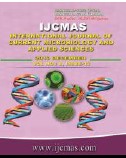


 National Academy of Agricultural Sciences (NAAS)
National Academy of Agricultural Sciences (NAAS)

|
PRINT ISSN : 2319-7692
Online ISSN : 2319-7706 Issues : 12 per year Publisher : Excellent Publishers Email : editorijcmas@gmail.com / submit@ijcmas.com Editor-in-chief: Dr.M.Prakash Index Copernicus ICV 2018: 95.39 NAAS RATING 2020: 5.38 |
Ocimum sanctum L. or “Tulsi” or Holy basil is a plant well known for its medicinal properties. This plant is rich in essential oil sequestered in peltate glands. The Tulsi is rich source of eugenol, methyl eugenol, chavicol, ursolic acid, rosmerinic acid and other phenolics and terpenes. Aloe barbadensis and Plantago ovata are plants rich in polysaccharides. These plants are very important medicinal plants. A. barbadensis is source of aloin which is used in various cosmetic products and P. ovata is the main source of Isabgol-Husk. DNA based studies in these and similar plants require optimization of DNA isolation method due to presence of high level of secondary metabolites and polysaccharides. Which generally hamper all downstream enzymatic analysis like PCR amplification. DNA isolated using standard DNA isolation method especially from stored leaves from such plants is not suitable for downstream enzymatic analysis like PCR. In present study, a DNA isolation method has been developed which results in high quality and intact DNA from Tulsi, A. barbadensis and P. ovata. This method is free from the use of liquid nitrogen, Phenol, and Cetyltrimethyl ammonium bromide and moreover efficient to isolate intact DNA which can be easily used for downstream molecular analysis. DNA isolated by newly developed method was successfully amplified by PCR reaction using random and specific primers.
 |
 |
 |
 |
 |